Free Landlord Tenant Agreement Template
A landlord tenant agreement, also called a residential lease agreement, is a legally binding contract that sets forth the terms of a rental arrangement between a property owner/manager and a tenant renting property.
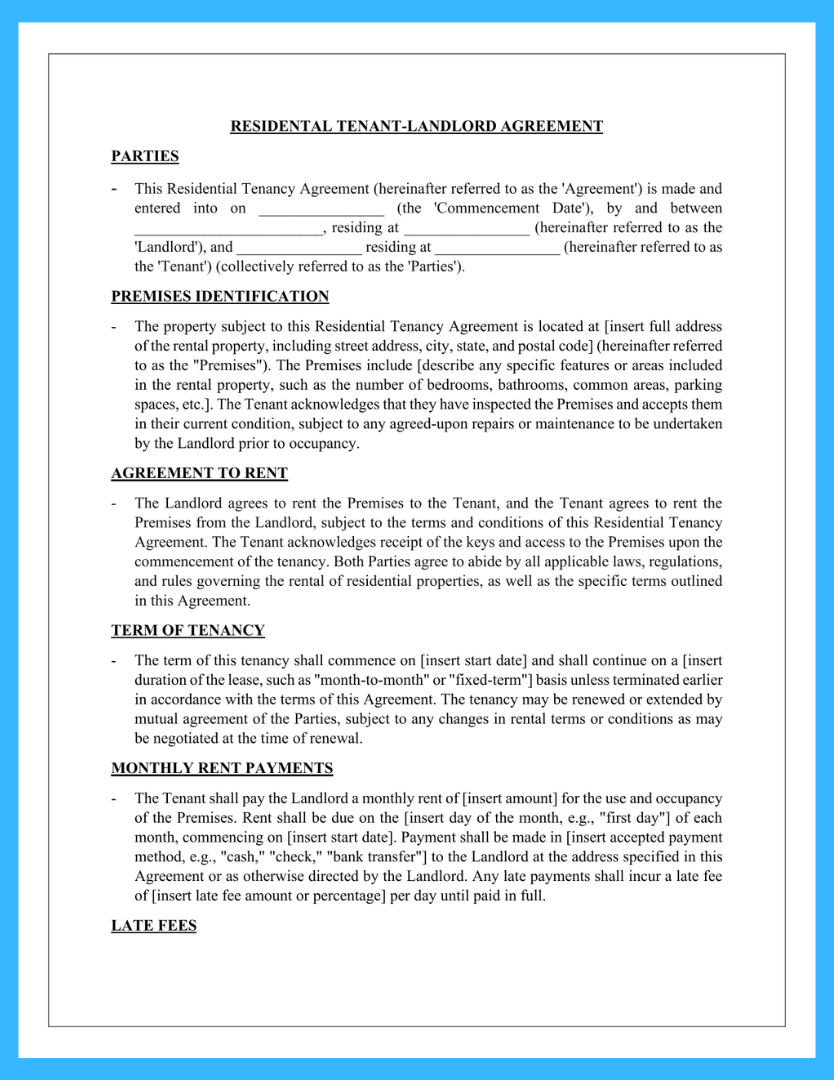
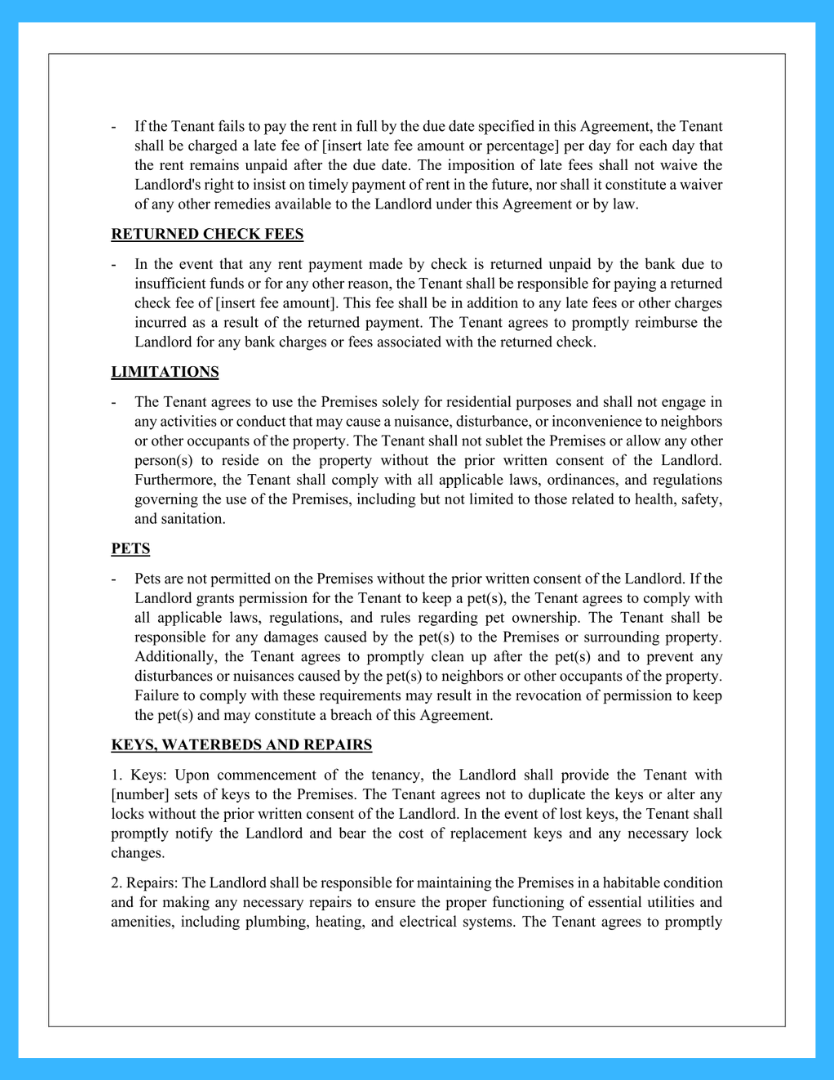
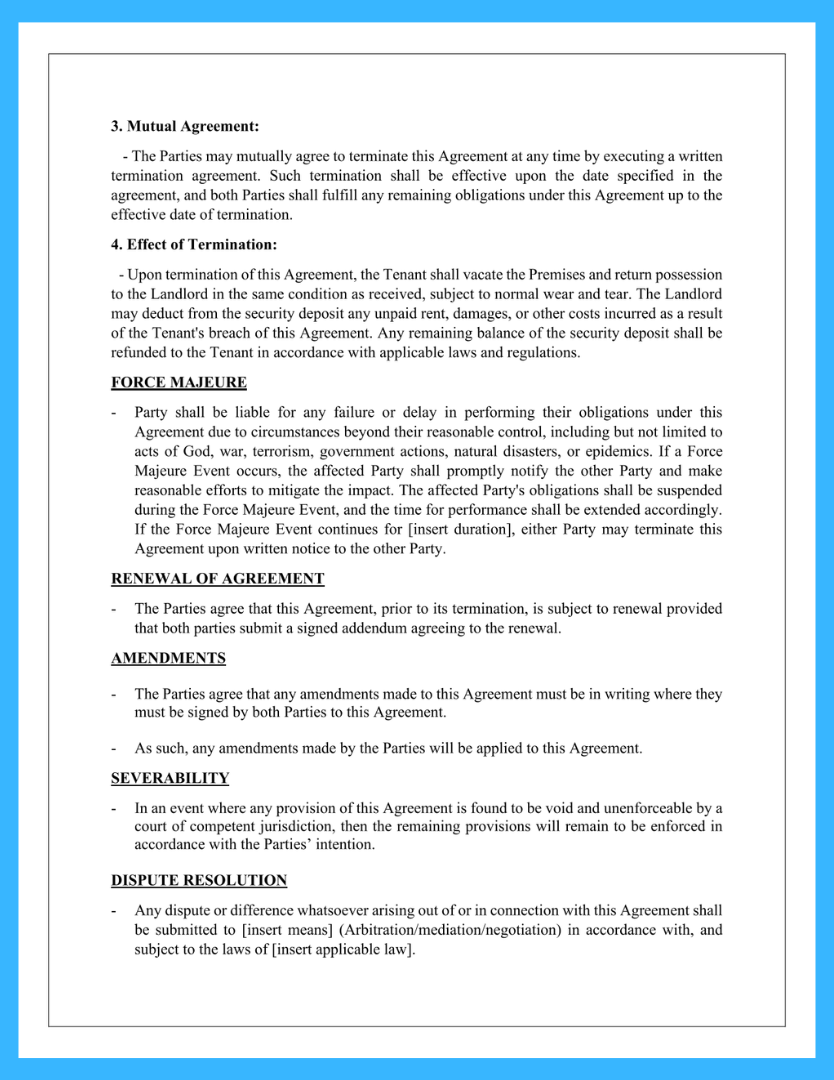
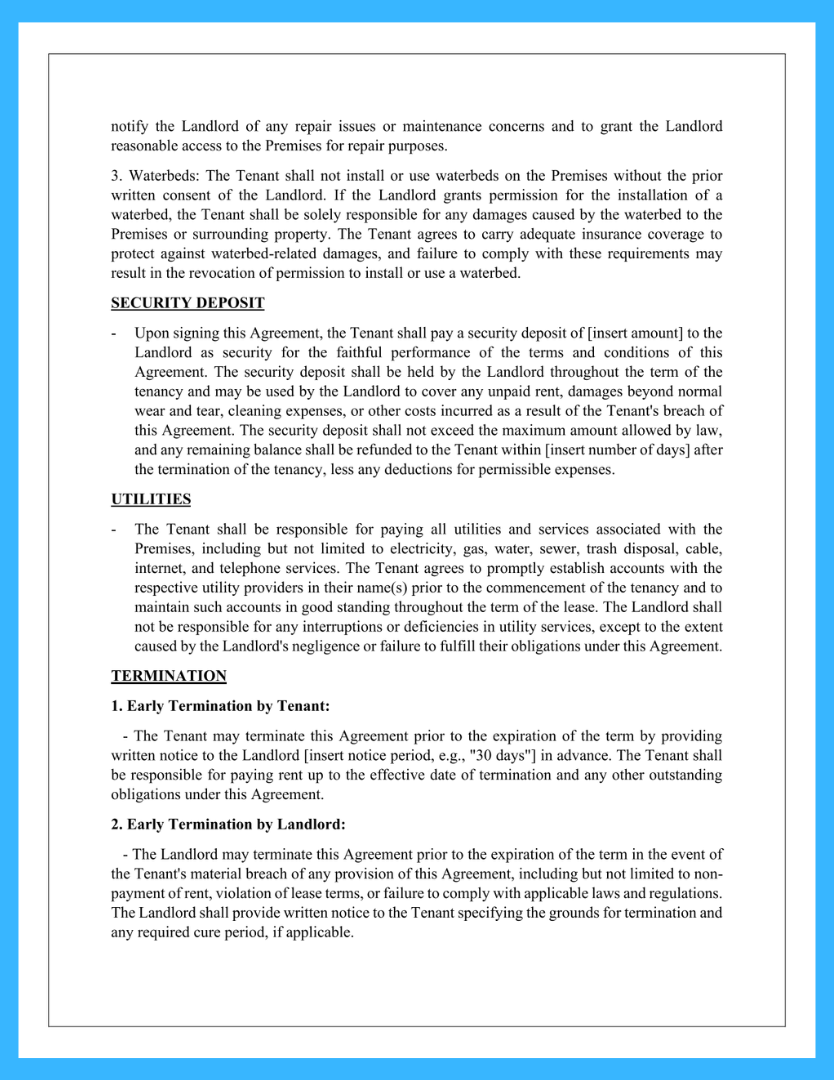
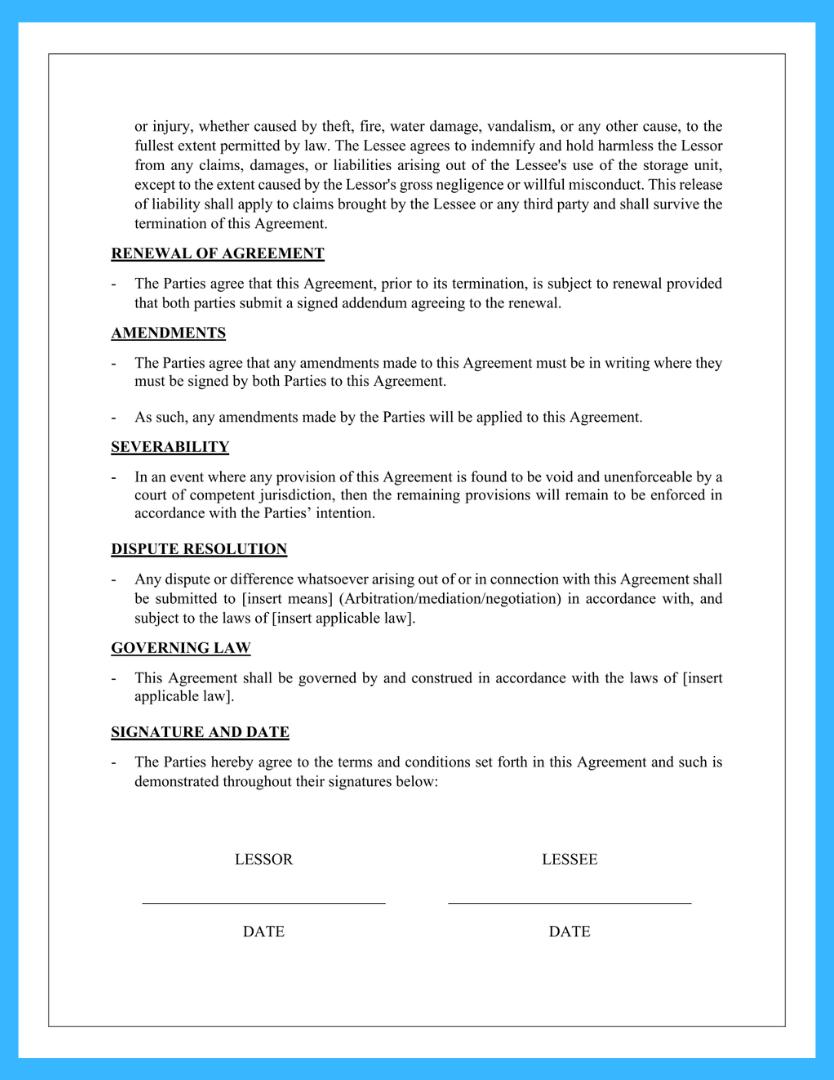
What is a Landlord Tenant Agreement?
A landlord tenant agreement, or rental agreement, is a legally binding contract between a property owner or manager (the landlord) and a tenant that stipulates the details, terms, rules, and conditions of renting a commercial or residential property. It provides a clear framework governing both parties’ relationship, rights, and responsibilities.
Typically, a lease agreement establishes specifics regarding the premises, rent payments and amounts, security deposit information, use of the property, maintenance and repairs, termination policies, and more. A thorough, detailed rental agreement benefits landlords and tenants alike, ensuring clear expectations, standards, and procedures regarding all aspects of the rental arrangement. Landlord tenant agreements may vary across states and municipalities due to differing landlord-tenant laws.
When creating a robust lease agreement, it is essential to clearly specify relevant information, including the full legal names of the landlord and tenant, the complete address of the rental property, the amount of rent and due dates, the length of the lease term, policies regarding pets, smoking, subletting, maintenance requests, and more. The agreement should outline expectations for both parties’ property conditions, security deposit details, late rent fees, and termination policies.
Additionally, the agreement can include information regarding pests, noise, guests, HVAC use, parking, storage, and other specifics relevant to the rental property. Comprehensive details in the rental agreement clarify responsibilities for both parties and help avoid potential disputes by setting clear ground rules upfront. It also provides legal recourse should either party violate the terms of the lease agreement. Getting the landlord-tenant agreement notarized is recommended for further legal protection.
Why a Landlord Tenant Agreement is Essential
A comprehensive lease agreement is critically important for landlords and tenants renting a residential or commercial property. For landlords, these legally binding contracts spell out rental terms, payments, policies, responsibilities, and more, protecting their rights and interests in the property.
This agreement allows them to manage the rental effectively, provide quality housing, minimize disputes, and take appropriate action when issues arise. For tenants, landlord-tenant agreements give them certainty regarding costs, maintenance, use of premises, and other aspects impacting their stay. Knowing the rules and expectations upfront prevents surprises down the road.
Additionally, the tenant has recourse options outlined in the contract should the landlord fail to uphold their end of the bargain. Overall, a residential lease agreement creates accountability on both sides, leading to more transparent, equitable, and successful rental arrangements beneficial to both parties.
When to Use a Landlord Tenant Agreement
A landlord tenant agreement, often called a lease or rental agreement, is essential for any property manager leasing real estate to a tenant, whether residential or commercial. These legally binding contracts should always exist before a renter enters or uses a property.
Many landlords require interested tenants to sign an agreement during the rental application process, after which they may proceed with further background checks for final approval. Then, upon acceptance, both parties will revisit the lease to add specifics like exact start and end dates.
Landlords will typically prepare and customize the rental lease agreement. During lease renewals are another typical occasion for revisiting and updating landlord tenant contracts, whether beginning a new rental arrangement or continuing an existing one, having an up-to-date, detailed, and legally compliant lease agreement protects both owners and renters throughout the leasing term.
Can I Create My Own Rental Agreement?
While landlords can create their own rental or lease agreements, they are strongly advised to use an attorney-approved, legally compliant template as the basis for any residential lease agreement. Many state, municipal, and federal laws govern residential and commercial rental properties that amateur DIY agreements may overlook.
Issues with properly addressing aspects like security deposit FAQs, tenant rights, discrimination, disclosure requirements, allowed grounds for evictions, maintenance and repair responsibilities, and more can open landlords up to legal problems down the road if not handled correctly in the lease documentation.
Additionally, professional rental agreements contain specific legal provisions that better protect the landlord’s rights and interests.
So, while a landlord may use software to customize the particulars of an agreement, the established backbone template comes from a trusted legal source, ensuring compliance across all necessary rental statutes and regulations applicable to the property. This best practice helps avoid problematic gaps, ambiguities, or contradictions that could invalidate clauses in the contract.
What to Include in a Landlord Tenant Agreement
A thorough, detailed lease agreement should contain several important sections to clarify expectations for both parties and ensure proper legal protections are in place. While specific rental contract requirements vary across states and municipalities, most standard leases include the following components.
Party Information
The introductory section of the lease documentation outlines and identifies key details on both the landlord and tenant(s). For the owner/manager, this includes full legal name(s), primary address, phone, and email.
On the renter side, details like the full legal name of the responsible tenant(s), current address, phone, email, and driver’s license number establish all parties to the agreement. Multiple means of contacting both parties ensure proper communication channels are in place.
Premises Description
A rental agreement must clearly describe the leased rental property and premises. This section includes the full legal address, unit number (if applicable), square footage, bedroom/bathroom count, on-site amenities, and details on furnishings/appliances included (if any). Having an accurate description legally establishes the exact rental space and parameters involved. Photographs and floorplans can also be helpful supplements.
Tenancy Terms
This section clarifies all timeline details related to the lease period and arrangements. Standard provisions include the exact start and end dates, options to renew/extend, notice periods required for termination, and specifics on submitting a security deposit, including refund policies/processes.
Outlining tenancy terms upfront ensures proper expectations. Timelines for providing notice and additional details on lease break policies are other helpful inclusions in this section.
Rent, Payment, & Fees
The lease should detail the total monthly rental rate, the exact due date each month, acceptable payment methods, and repercussions for late payments, including fees. Address grace periods, application of partial payments, bad check fees, and pricing for early lease termination.
Both standard recurring monthly rent and any additional charges/fees should be defined. It is essential to outline when your renters will pay rent, which channels they’ll use, and how they’ll do it upfront.
Security Deposit Details
A standard rental agreement stipulates security deposit policies, including the precise amount required upfront from the tenant(s), where funds will be held, the conditions for full or partial withholding by the landlord, interest payments (where applicable), and the expected timeframe for return upon lease termination if owed back.
Tenant’s security deposit processes and accounting should be transparent to the renter per state statutes. Outlining timetables and documentation procedures regarding deposit accounting, deductions, and refund processing provides helpful clarity in your rental agreement.
Limits on Use
To protect the rental property, landlords institute restrictions around use through the lease documentation. This may include limiting occupancy to the tenant(s) named on the written agreement, prohibitions on subletting or Airbnb-type rentals without express permission, guidelines for pets/smoking if allowed, compliance with all applicable HOA bylaws, restrictions on excessive noise, requirements around reporting needed repairs, and more.
The contract should establish agreed-upon property usage to prevent issues. Address rules regarding guests, storage, parking, and common spaces/amenities as needed.
Pet Policy
The lease agreement addresses restrictions such as size, weight, breed limitations, and pet deposit/fee requirements if pets are allowed. Policies should cover both initial and renewal approval processes for pets and consequences around unauthorized animals. Outlining expectations up front clarifies rights on both sides. Cleaning expectations, damages coverage, and pet waste handling can be covered.
Repairs & Maintenance
Standard lease documentation details the division of responsibilities between tenant and landlord regarding rental property maintenance. This covers both who handles regular upkeep and the process for addressing repairs, including expected timeframes, prior approvals needed, and cost accountability. Establishing protocols prevents disputes when issues arise. Emergency repair procedures warrant particular attention and coordination in this section.
Utilities & Electricity
Lease contracts should reflect the division of utility and electricity payments between landlord and renter. If the tenant is responsible for some or all utilities, specifics would be provided around establishing accounts in their name and maintaining payments to avoid the risk of shutoff. Including utility billing processes sets expectations and protects landlord property in vacant periods between tenants. Specifying any shared metering and proportional allocations of costs provides helpful clarity.
Renewal
Standard lease agreements detail whether the tenant has the option to renew at the end of the lease term and requirements around providing advance notice to the landlord. Policies may also indicate if month-to-month conversions are allowed following expiration and at what rates. Clarifying renewal procedures provides needed certainty. Outlining timetables and proper channels for conveying renewal requests or vacating notices assists coordination.
Modification & Termination
Landlord tenant contracts outline specific protocols and required notices associated with mid-lease modifications and early termination rights. This agreement protects both parties should changes become necessary, ensuring proper legal processes are followed.
For instance, landlords may stipulate conditions like continued rent obligations until re-rented. Including details on final inspection scheduling also provides helpful direction. Outline if and when lease-breaking fees apply should the tenant opt to vacate before the expiration date without covering extenuating circumstances prematurely.
It can also be helpful to document what is deemed valid grounds for early lease termination without financial implications, including military orders or eligible hardship conditions.
General Terms
This standard section captures “boilerplate” legal provisions not addressed elsewhere, including rules around interpretation, severability of invalid clauses, non-waiver of the breach, successor interests, handling of legal notices, and more. These documents protect landlord and tenant interests in events not explicitly outlined.
Statements regarding governing state laws, legal jurisdiction, enforceability, and signatures also reside here. Ensure that mandatory federal disclosures including the Lead Disclosure Rule, and any state-level notices like California’s Proposition 65 warnings are highlighted. Outlining where tenants can access property owner’s rules and community policies provides helpful pointers for quickly directing new occupants.
Signatures
The lease culminates with dated wet or e-signed approval by the landlord and tenants. Signature fields should allow applying initials to individual pages as warranted in addition to validating the entire document. Legally validating the agreement with participant signatures cements the rental arrangements and parties’ consent. Having tenant and landlord e-sign via Signaturely provides smooth, legally-binding digital convenience.
Provide clear instructions on the signature process in your own lease agreement process – whether collecting handwritten names directly on paper documents, using an e-signature solution, or both. Outline requirements like attaching copies of photo identification.
For wet signatures, consider including a customer-focused statement like “Thank you for your business,” with the signature field positioned prominently near the end. Or choose an e-signature platform providing such pleasantries automatically upon signing the lease agreement. Either option contributes to positive leasing experiences.
It’s also essential to send follow-up emails to new tenants with helpful next steps including links for rental payments, maintenance requests, community info, and contacts. Ongoing cordial relations between landlords and occupants directly influence occupancy rates and pride in property caretaking.
Download our free example
Landlord Tenant Agreement Template
We’ve got your back here at Signaturely, and we’re ready to help make stress-free contracts a reality. Forget the confusing paperwork and overwhelming legal jargon – get easy, breezy contract templates in minutes with our free template.
Tips for Landlords Leasing a Property
Effectively managing rental properties requires landlords to follow best practices when screening applicants, preparing the unit, establishing agreements, and handling various processes over the course of the leasing term. Below are several critical tips for owners to employ when getting ready to take on tenants in a new residential lease agreement.
Arrange a Viewing
Before approving any rental applications, landlords should meet prospective tenants in person by arranging a showing of the unit. This provides the chance to get a sense of responsiveness, professionalism, comportment, and other intangibles when interacting face-to-face. An on-site walkthrough lets the applicant view specifics like space, layout, storage, and amenities firsthand.
Providing a property tour checklist can help guide the walkthrough while keeping conversations productive. It can be helpful to encourage applicants to take photos and measurements during tours to allow further evaluation after leaving. Follow up within 24 hours of showings to get a sense of continued interest and, ideally, secure a residential lease agreement application.
Check Tenant References
Reference and background checks during the screening process help landlords verify applicant details while determining reliability for consistent rent payments and property care based on prior living arrangements. Speaking to provided references and contacting previous landlords can prove enlightening before approving a new tenant.
Before drafting a lease agreement, asking specific questions regarding past payment timeliness, lease rule compliance, property condition upon move-out, and other insights assists the diligence. Request contact info for at least three references, including past landlords, to establish a pattern of behavior. Checking public records for bankruptcies, court judgments, and criminal history is also advisable.
Run a Credit Check
Similarly, running a credit check on rental candidates provides objective insight into financial management skills and the likelihood of paying rent on time each month. While credit score thresholds vary by situation, landlords should analyze credit reports to uncover any red flags of deficient scores or prior evictions. Set a clear policy on minimum credit scores that you find acceptable to mitigate risk.
Standard landlord credit checks provide details beyond the credit score itself, including total outstanding debt, payment history across all credit lines, collections notices, bankruptcies, foreclosures, tax liens, and related items influencing applicant viability.
Understand Your Responsibilities
To remain compliant, landlords must educate themselves on legal obligations and best practices for rental properties in their state/city. Responsibilities may cover security deposits, repairs, discrimination rules, tenant privacy, move-in/move-out inspections, notice requirements, and more.
Knowing regulations protects owners from litigation while clarifying processes for tenants as well. Set aside adequate time to research landlord-tenant laws thoroughly, connect with legal counsel as needed, and create custom lease agreements incorporating required provisions before listing your unit.
Ongoing diligence allows adapting business practices to any changing rules. Sign up for property owner resources from local real estate investor networks, too.
Brush Up on Tenant Law
Similarly, landlords should clearly understand relevant real estate and landlord-tenant laws in their jurisdiction to protect tenant legal rights. Issues around security deposits, discrimination, repairs, termination notices, entry permissions, and more are typically addressed. Ignorance of tenant law risks landlord violations.
Staying current as statutes and ordinances evolve is critical. Review federal regulations, including the Fair Housing Act, Americans with Disabilities Act, Lead Disclosure Rule, and other mandates, with particular attention. Become familiar with any state or local overlays providing additional tenant protections beyond federal provisions.
For example, many urban areas enforce rent control and just cause eviction policies influencing residential lease agreement practices. Consult legal counsel to confirm the interpretation of any unclear aspects, ideally maintaining an ongoing advisor relationship to contact as questions arise. Proactively researching before an issue occurs helps prevent noncompliance.
Put Everything in Writing
To avoid miscommunications or confusion, landlords should document all policies, approvals, denials, notices, modifications, and other lease agreements affecting tenants in writing. Verbal commitments can break down without formal records. Signed documentation protects both parties should disputes arise later.
Go Paperless
With innovations in e-signature technology, landlords can now quickly implement paperless systems for onboarding tenants, executing contracts, collecting monthly rent, and other streamlined conveniences. Platforms like Signaturely allow digital secure management of the entire rental process to maximize productivity. Reducing manual paperwork saves landlords significant time while still maintaining legal records.
Automating notifications and reminders also assists with management. You can upload templates of a standard lease agreement, disclosures, notice to vacate, violation notices, and more, so executing any forms only takes seconds.
Automatic tracking provides status visibility on document progress. Custom digital workflows handle repetitive processes efficiently at scale for professional landlords managing multiple units.
How to Create a Landlord Tenant Agreement With Signaturely
The easiest and most efficient way for landlords to generate a custom, legally compliant rental agreement involves using Signaturely’s intuitive online template. Within the software, landlords can quickly tailor all aspects of the lease contract, including property details, tenant info, rental rates/terms, policies, and more.
Signaturely then automatically customizes the paperwork based on landlord inputs for a thorough, accurate own lease agreement ready for digital signatures. Landlords simply send the completed contract link via email to tenants to e-sign.
The platform secures sensitive documents and binding e-signatures with bank-level encryption, ensuring legal validity while keeping the entire rental process digital for maximum productivity. With advanced tools optimizing lease creation from any device, Signaturely streamlines onboarding so landlords can get tenants moved in quickly with a free rental lease agreement.
FAQs About Rental Agreements
Below are a few frequently asked questions about drafting a rental agreement.
How do you write a tenancy agreement?
Landlords can easily create custom rental agreements through user-friendly platforms like Signaturely, which provide intuitive templates covering all necessary legal components that automatically adjust based on landlord inputs for each unique rental property situation.
What are the tenancy types?
Common rental agreement types include fixed-term leases lasting six months one year, shorter-term agreements, and open-ended month-to-month tenancies, allowing flexibility. Rentals may involve primary residences, secondary vacation properties, commercial spaces like storefronts or offices, event venues, and more.
What You Need to Remember About Landlord Tenant Agreements
A residential lease agreement formalizes rental arrangements for real estate properties, clarifying rights, obligations, and expectations for property owners/managers and tenants throughout the duration. Having legally sound, comprehensive lease documentation prevents misunderstandings while providing proper protections and recourse should conflicts arise.
Rental contracts should establish all approved occupants, premises details, rent rates/timelines, security deposit policies, usage guidelines, maintenance divisions, pet allowances, termination policies, and other specifics tailored to the rental property and parties involved. A well formulated lease agreement enables rental property owners to institute equitable rules benefitting all stakeholders. And Signaturely’s sample lease agreement helps you take that proactiveness one step further.
Keeping your residential lease agreement updated, addressing changes promptly in writing, understanding governing laws, and maintaining open communications are vital principles for effective landlord tenant relationships.
Free Landlord Tenant Agreement Template
RESIDENTAL TENANT-LANDLORD AGREEMENT
PARTIES
- This Residential Tenancy Agreement (hereinafter referred to as the ‘Agreement’) is made and entered into on ________________ (the ‘Commencement Date’), by and between ________________________, residing at ________________ (hereinafter referred to as the ‘Landlord’), and ________________ residing at ________________ (hereinafter referred to as the ‘Tenant’) (collectively referred to as the ‘Parties’).
PREMISES IDENTIFICATION
- The property subject to this Residential Tenancy Agreement is located at [insert full address of the rental property, including street address, city, state, and postal code] (hereinafter referred to as the “Premises”). The Premises include [describe any specific features or areas included in the rental property, such as the number of bedrooms, bathrooms, common areas, parking spaces, etc.]. The Tenant acknowledges that they have inspected the Premises and accepts them in their current condition, subject to any agreed-upon repairs or maintenance to be undertaken by the Landlord prior to occupancy.
AGREEMENT TO RENT
- The Landlord agrees to rent the Premises to the Tenant, and the Tenant agrees to rent the Premises from the Landlord, subject to the terms and conditions of this Residential Tenancy Agreement. The Tenant acknowledges receipt of the keys and access to the Premises upon the commencement of the tenancy. Both Parties agree to abide by all applicable laws, regulations, and rules governing the rental of residential properties, as well as the specific terms outlined in this Agreement.
TERM OF TENANCY
- The term of this tenancy shall commence on [insert start date] and shall continue on a [insert duration of the lease, such as “month-to-month” or “fixed-term”] basis unless terminated earlier in accordance with the terms of this Agreement. The tenancy may be renewed or extended by mutual agreement of the Parties, subject to any changes in rental terms or conditions as may be negotiated at the time of renewal.
MONTHLY RENT PAYMENTS
- The Tenant shall pay the Landlord a monthly rent of [insert amount] for the use and occupancy of the Premises. Rent shall be due on the [insert day of the month, e.g., “first day”] of each month, commencing on [insert start date]. Payment shall be made in [insert accepted payment method, e.g., “cash,” “check,” “bank transfer”] to the Landlord at the address specified in this Agreement or as otherwise directed by the Landlord. Any late payments shall incur a late fee of [insert late fee amount or percentage] per day until paid in full.
LATE FEES
- If the Tenant fails to pay the rent in full by the due date specified in this Agreement, the Tenant shall be charged a late fee of [insert late fee amount or percentage] per day for each day that the rent remains unpaid after the due date. The imposition of late fees shall not waive the Landlord’s right to insist on timely payment of rent in the future, nor shall it constitute a waiver of any other remedies available to the Landlord under this Agreement or by law.
RETURNED CHECK FEES
- In the event that any rent payment made by check is returned unpaid by the bank due to insufficient funds or for any other reason, the Tenant shall be responsible for paying a returned check fee of [insert fee amount]. This fee shall be in addition to any late fees or other charges incurred as a result of the returned payment. The Tenant agrees to promptly reimburse the Landlord for any bank charges or fees associated with the returned check.
LIMITATIONS
- The Tenant agrees to use the Premises solely for residential purposes and shall not engage in any activities or conduct that may cause a nuisance, disturbance, or inconvenience to neighbors or other occupants of the property. The Tenant shall not sublet the Premises or allow any other person(s) to reside on the property without the prior written consent of the Landlord. Furthermore, the Tenant shall comply with all applicable laws, ordinances, and regulations governing the use of the Premises, including but not limited to those related to health, safety, and sanitation.
PETS
- Pets are not permitted on the Premises without the prior written consent of the Landlord. If the Landlord grants permission for the Tenant to keep a pet(s), the Tenant agrees to comply with all applicable laws, regulations, and rules regarding pet ownership. The Tenant shall be responsible for any damages caused by the pet(s) to the Premises or surrounding property. Additionally, the Tenant agrees to promptly clean up after the pet(s) and to prevent any disturbances or nuisances caused by the pet(s) to neighbors or other occupants of the property. Failure to comply with these requirements may result in the revocation of permission to keep the pet(s) and may constitute a breach of this Agreement.
KEYS, WATERBEDS AND REPAIRS
- Keys: Upon commencement of the tenancy, the Landlord shall provide the Tenant with [number] sets of keys to the Premises. The Tenant agrees not to duplicate the keys or alter any locks without the prior written consent of the Landlord. In the event of lost keys, the Tenant shall promptly notify the Landlord and bear the cost of replacement keys and any necessary lock changes.
- Repairs: The Landlord shall be responsible for maintaining the Premises in a habitable condition and for making any necessary repairs to ensure the proper functioning of essential utilities and amenities, including plumbing, heating, and electrical systems. The Tenant agrees to promptly notify the Landlord of any repair issues or maintenance concerns and to grant the Landlord reasonable access to the Premises for repair purposes.
- Waterbeds: The Tenant shall not install or use waterbeds on the Premises without the prior written consent of the Landlord. If the Landlord grants permission for the installation of a waterbed, the Tenant shall be solely responsible for any damages caused by the waterbed to the Premises or surrounding property. The Tenant agrees to carry adequate insurance coverage to protect against waterbed-related damages, and failure to comply with these requirements may result in the revocation of permission to install or use a waterbed.
SECURITY DEPOSIT
- Upon signing this Agreement, the Tenant shall pay a security deposit of [insert amount] to the Landlord as security for the faithful performance of the terms and conditions of this Agreement. The security deposit shall be held by the Landlord throughout the term of the tenancy and may be used by the Landlord to cover any unpaid rent, damages beyond normal wear and tear, cleaning expenses, or other costs incurred as a result of the Tenant’s breach of this Agreement. The security deposit shall not exceed the maximum amount allowed by law, and any remaining balance shall be refunded to the Tenant within [insert number of days] after the termination of the tenancy, less any deductions for permissible expenses.
UTILITIES
- The Tenant shall be responsible for paying all utilities and services associated with the Premises, including but not limited to electricity, gas, water, sewer, trash disposal, cable, internet, and telephone services. The Tenant agrees to promptly establish accounts with the respective utility providers in their name(s) prior to the commencement of the tenancy and to maintain such accounts in good standing throughout the term of the lease. The Landlord shall not be responsible for any interruptions or deficiencies in utility services, except to the extent caused by the Landlord’s negligence or failure to fulfill their obligations under this Agreement.
TERMINATION
- Early Termination by Tenant:
– The Tenant may terminate this Agreement prior to the expiration of the term by providing written notice to the Landlord [insert notice period, e.g., “30 days”] in advance. The Tenant shall be responsible for paying rent up to the effective date of termination and any other outstanding obligations under this Agreement.
- Early Termination by Landlord:
– The Landlord may terminate this Agreement prior to the expiration of the term in the event of the Tenant’s material breach of any provision of this Agreement, including but not limited to non-payment of rent, violation of lease terms, or failure to comply with applicable laws and regulations. The Landlord shall provide written notice to the Tenant specifying the grounds for termination and any required cure period, if applicable.
- Mutual Agreement:
– The Parties may mutually agree to terminate this Agreement at any time by executing a written termination agreement. Such termination shall be effective upon the date specified in the agreement, and both Parties shall fulfill any remaining obligations under this Agreement up to the effective date of termination.
- Effect of Termination:
– Upon termination of this Agreement, the Tenant shall vacate the Premises and return possession to the Landlord in the same condition as received, subject to normal wear and tear. The Landlord may deduct from the security deposit any unpaid rent, damages, or other costs incurred as a result of the Tenant’s breach of this Agreement. Any remaining balance of the security deposit shall be refunded to the Tenant in accordance with applicable laws and regulations.
FORCE MAJEURE
- Party shall be liable for any failure or delay in performing their obligations under this Agreement due to circumstances beyond their reasonable control, including but not limited to acts of God, war, terrorism, government actions, natural disasters, or epidemics. If a Force Majeure Event occurs, the affected Party shall promptly notify the other Party and make reasonable efforts to mitigate the impact. The affected Party’s obligations shall be suspended during the Force Majeure Event, and the time for performance shall be extended accordingly. If the Force Majeure Event continues for [insert duration], either Party may terminate this Agreement upon written notice to the other Party.
RENEWAL OF AGREEMENT
- The Parties agree that this Agreement, prior to its termination, is subject to renewal provided that both parties submit a signed addendum agreeing to the renewal.
AMENDMENTS
- The Parties agree that any amendments made to this Agreement must be in writing where they must be signed by both Parties to this Agreement.
- As such, any amendments made by the Parties will be applied to this Agreement.
SEVERABILITY
- In an event where any provision of this Agreement is found to be void and unenforceable by a court of competent jurisdiction, then the remaining provisions will remain to be enforced in accordance with the Parties’ intention.
DISPUTE RESOLUTION
- Any dispute or difference whatsoever arising out of or in connection with this Agreement shall be submitted to [insert means] (Arbitration/mediation/negotiation) in accordance with, and subject to the laws of [insert applicable law].
GOVERNING LAW
- This Agreement shall be governed by and construed in accordance with the laws of [insert applicable law].
SIGNATURE AND DATE
- The Parties hereby agree to the terms and conditions set forth in this Agreement and such is demonstrated throughout their signatures below:
LANDLORD |
TENANT _______________________________ |
DATE
_______________________________
|
DATE
_______________________________ |
Download Our Free Landlord Tenant Agreement Template Today
Don’t waste any more time trying to craft the perfect landlord tenant agreement. Our simple landlord tenant agreeement template is ready and ready to download in one quick, convenient click—no more complicated documents for you or your clients to fill out.
Just download, customize, and off you go!